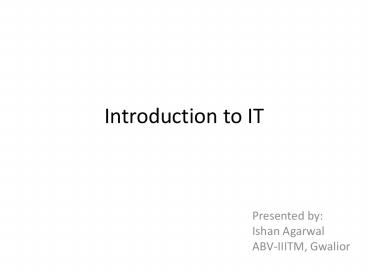Introduction to IT - PowerPoint PPT Presentation
1 / 17
Title:
Introduction to IT
Description:
Introduction to IT Presented by: Ishan Agarwal ABV-IIITM, Gwalior e-commerce Electronic commerce, commonly known as e-commerce, consists of the buying and selling of ... – PowerPoint PPT presentation
Number of Views:32
Avg rating:3.0/5.0
Title: Introduction to IT
1
Introduction to IT
- Presented by
- Ishan Agarwal
- ABV-IIITM, Gwalior
2
e-commerce
- Electronic commerce, commonly known as
e-commerce, consists of the buying and selling of
products or services over electronic systems such
as the Internet and other computer networks.
3
e-commerce cont.
- Some common applications related to electronic
commerce are the following - Content Management Systems
- Accounting and finance systems
- Orders and shipment information
- Enterprise and client information reporting
- Domestic and international payment systems
- On-line Shopping
- email and messaging
4
Multimedia
- Multimedia represents the convergence of text,
pictures, video and sound into a single form. - A site with a specific purpose can use Multimedia
to make it more attractive to user.
5
Multimedia Cont.
- Multimedia Applications
- Distance and interactive training
- CAD/CAM
- Air traffic control
- Public Digital libraries
- business/Office Executive information systems
- Remote consulting systems
- Video conferencing
- Multimedia documents
- Advertising
- Electronic publishing
6
e-governance
- Electronic Governance is the application of
Information Technology to bring SMART governance.
- The Indian government is using IT to facilitate
governance. The IT industry is doing its bit to
help as public-private partnerships become the
order of the day.
7
e-governance
- IT enables the delivery of government services as
it caters to a large base of people across
different segments and geographical locations. - The effective use of IT services in government
administration can greatly enhance existing
efficiencies, drive down communication costs, and
increase transparency in the functioning of
various departments. - It provides citizens easy access to tangible
benefits, be it through simple applications such
as online form filling, bill sourcing and
payments, or complex applications like distance
education and tele-medicine.
8
Robotics
- Robotics requires a working knowledge of
electronics, mechanics and software. - The commonly used programming language for robots
is labview. - All robotic applications need parallelism and
event-based programming.
9
Robotics Cont.
- Robots are used in welding as arc welding and
plasma cutting. - In material handling like loading and unloading
of heavy machines and goods. - Except this they are also used in Robotic
Assembling, Drilling etc.
10
Artificial Intelligence
- Artificial intelligence, by claiming to be able
to recreate the capabilities of the human mind,
is a both challenge and an inspiration for IT
industry.
11
Artificial Intelligence Cont.
- game playing
- speech recognition
- computer vision
- expert systems
- heuristic classification
12
Wireless Networking
- Wireless telecommunications networks are
generally implemented with some type of remote
information transmission system that uses
electromagnetic waves. - Cellular phones are part of huge wireless network
systems. - Also in battle field this technology is used for
communication. walkie-talkie is an example of
this type of communication.
13
Speech Processing
- Speech processing refers to the acquisition,
manipulation, storage, transfer and output of
human utterances by a computer. The main goals
are the recognition, synthesis and compression of
human speech. - Voice security systems are example of this
technology.
14
Web 2.0
- Web 2.0 is a term describing changing trends in
the use of World Wide Web technology and web
design that aim to enhance creativity,
information sharing, and collaboration among
users. - Rich-Internet application techniques such as
AJAX, Adobe Flash, Flex, Java, Silverlight and
Curl have evolved that have the potential to
improve the user-experience in browser-based
applications.
15
Dot Net
- The Microsoft .NET Framework is a software
technology that is available with several
Microsoft Windows operating systems. It includes
a large library of pre-coded solutions to common
programming problems. - Languages that are supported by this platform to
develop software are C, J, Visual C, VB.Net,
ASP.Net.
16
Linux
- The name "Linux" comes from the Linux kernel,
originally written in 1991 by Linus Torvalds. - It is a free open source software.
- The system's utilities and libraries usually come
from the GNU operating system, this contribution
is the basis for the alternative name GNU/Linux.
17
XML
- XML stands for Extensible Markup Language.
- It is classified as an extensible language
because it allows its users to define their own
elements.































